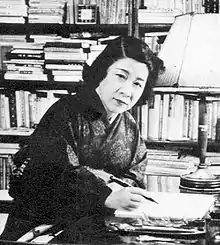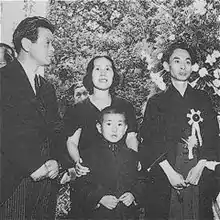Fumiko Hayashi (author)
Fumiko Hayashi (林 芙美子, Hayashi Fumiko, December 31, 1903 or 1904[lower-alpha 1] – June 28, 1951) was a Japanese novelist and poet.
Fumiko Hayashi | |
|---|---|
 | |
| Native name | 林 芙美子 |
| Born | December 31, 1903 Shimonoseki, Yamaguchi, Japan |
| Died | June 28, 1951 (aged 47) Tokyo, Japan |
| Occupation | Novelist and poet |
| Language | Japanese |
| Citizenship | Japanese |
Life and career
Hayashi was born in Shimonoseki, Japan. The daughter of an itinerant peddlar, Hayashi was raised in abject poverty.[1] When Hayashi was seven, her mother ran away with a manager of her common-law husband's store, and afterwards the three worked in Kyūshū as itinerant merchants. After graduating from high school in 1922, Hayashi moved to Tokyo with a lover and lived with several men before settling into marriage with the painter Rokubin Tezuka (手塚 緑敏) in 1926, barely managing to support herself with a variety of menial jobs. [2]
Many of her works revolve around themes of free spirited women and troubled relationships. One of her best-known works is Hōrōki (放浪記, 1927; translated into English as "Vagabond's Song" or "Diary of a Vagabond"), which was adapted into the anime Wandering Days. Another is her late novel Ukigumo (Floating Clouds, 1951), which was made into a film by Mikio Naruse in 1955. Naruse adapted several of her books, and also directed a biographical film about her in 1962, Horoki (A Wanderer's Notebook).

Hayashi's work is notable as well for its feminist themes. She was later to face criticism for accepting sponsored-trips by the Japanese military government to occupied China, from where she reported positively on Japanese administration. In 1942–43, as part of a larger group of women writers, she also travelled to Southeast Asia, spending around half a year, primarily in Java and Sumatra. Some of her activities were reported in both the local Indonesian presses, as well as in Japan.
Joan E. Ericson's (1997) translations and analysis of the immensely popular Hōrōki and Suisen (Narcissus) suggest that Hayashi's appeal is rooted in the clarity with which she conveys the humanity not just of women, but also others on the underside of Japanese society.
Works
Works by Hayashi include:
- 1930: Horoki (Diary of a Vagabond) – autobiographical novel; source for Naruse's 1962 film A Wanderer's Notebook (Horoki)[3]
- 1931: "Fukin to uo no machi" ("The Accordion and the Fish Town") – short story
- 1933: Seihin no sho (A record of Honorable Poverty) – autobiographical novel
- 1934: Nakimushi Kozo (Cry Baby) – novel – source for Shirō Toyoda's 1938 film Crybaby Apprentice (Nakimushi kozo)
- 1936: Inazuma (Lightning) – novel; source for Naruse's 1952 film Lightning (Inazuma)[3]
- 1947: Uzushio (Swirling Currents) – novel
- 1948: "Bangiku" ("Late Chrysanthemum") – short story; winner of the Women's Literary Award; one of the sources for Naruse's 1954 film Late Chrysanthemums (Bangiku)[3]
- translated twice: by John Bester (Japan Quarterly) and Lane Dunlop (ISBN 978-0865472297)
- 1949: "Shirosagi" – short story; one of the sources for Naruse's 1954 film Late Chrysanthemums[3]
- 1949: "Suissen" – short story; one of the sources for Naruse's 1954 film Late Chrysanthemums[3]
- 1950: Chairo no me – novel; source for Naruse's 1953 film Wife (Tsuma)[3]
- 1951: Ukigumo (Floating Clouds) – novel; source for Naruse's 1955 film Floating Clouds (Ukigumo). Translated by Lane Dunlop (ISBN 978-0231136297)
- 1951: Meshi (Repast) – novel; source for Naruse's 1951 film Repast (Meshi)[3]
See also
- Japanese literature
- List of Japanese authors
Notes
- Japanese sources disagree on the birth year.
References
- Lagassé, Paul (January 2000). Fumiko Hayashi. ISBN 9780787650155.
- Lagassé, Paul (January 2000). Fumiko Hayashi. ISBN 9780787650155.
- Goble, A., ed. (1999). The Complete Index to Literary Sources in Film. Walter de Gruyter. p. 212. ISBN 9783110951943.
Bibliography
- Ericson, Joan E. (1997). Be a Woman: Hayashi Fumiko and Modern Japanese Women's Literature. Honolulu: University of Hawaii Press.
- Horton, William Bradley. (2014). 'Tales of a Wartime Vagabond: Hayashi Fumiko and the Travels of Japanese Writers in Early Wartime Southeast Asia', in Under Fire: Women and World War II. Verloren Publishers.
External links
| Wikimedia Commons has media related to Hayashi Fumiko. |
- J'Lit | Authors : Fumiko Hayashi | Books from Japan (in English)
- Works by or about Fumiko Hayashi at Internet Archive
- Works by Fumiko Hayashi at LibriVox (public domain audiobooks)
